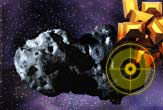

(Space.com) Spectroscopic studies suggest, and 'ground-truth' chemical assays of meteorites confirm, that a wide range of resources are present in asteroids and comets, including nickel-iron metal, silicate minerals, semiconductor and platinum group metals, water, bituminous hydrocarbons, and trapped or frozen gases including carbon dioxide and ammonia.
As one startling pointer to the unexpected riches in asteroids, many stony and stony-iron meteorites contain Platinum Group Metals at grades of up to 100 ppm (or 100 grams per ton).
Operating open pit platinum and gold mines in South Africa and elsewhere mine ores of grade 5 to 10 ppm, so grades of 10 to 20 times higher would be regarded as spectacular if available in quantity, on Earth.
Although the general population of the human race will reside on terrestrial worlds (such as the Moon, Mars, Europe, etc.), many colonists may find themselves employed by mining operations harvesting these solar rocks.
Mining asteroids may not only be more practical, but it may also prove to be more economical as well.

(Space.com) Since the competing source of raw materials is "delivery by launch from Earth," which imposes a launch cost per kilogram presently above $10,000 per kg, this same figure represents the upper bound of what recovered asteroidal material would be presently worth in low earth orbit.
Future large scale economic activity in orbit is unlikely to develop however until launch cost drops to something in the range $500 to $1,000 per kilogram to LEO. [...]
Note that the asteroidal materials we are talking about are, simply, water, nickel-iron metal, hydrocarbons, and silicate rock. Purified, and made available in low earth orbit, they will be worth something like $500,000 per ton, by virtue of having avoided terrestrial gravity's "launch cost levy."
Initially launching operations to harvest the space boulders will be costly, and of course the rubble gathered from the mining operations will have to be filtered "for goodies."
However, in the long term, seizing upon this initiative will enable humanity to obtain a wealth of mineral resources. This will aid in building future colony bases, star ships, as well as space stations inexpensively, allowing a future space economy to develop and flourish.
Want more space geek news? Then subscribe below via email, RSS or twitter for free updates! Prefer another service? How about via RSS or follow Colony Worlds on Twitter!




![ColonyWorlds[at]Gmail[dot]com](http://img.photobucket.com/albums/v438/hiddennook/ColonyWorlds.png)







No comments:
Post a Comment
You can either visit the stars or watch them from afar.
But if you choose the former, you'll definitely get a better view.
~Darnell Clayton, 2007
Note: You do not need a Blogger account in order to comment, but you do need to solve the universal puzzle below.